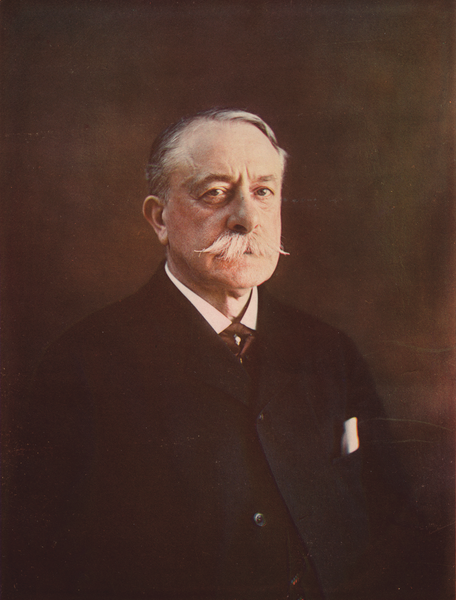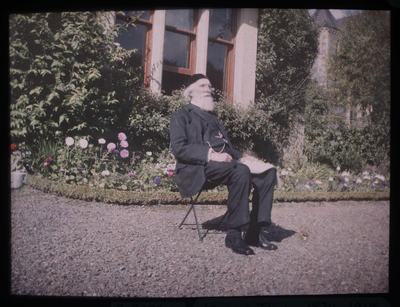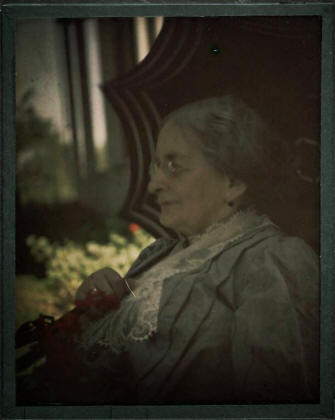First colour photo |
|||||
1. The technology |
2. The human subject |
||||
First colour photo of a person, and first colour portrait photo |
|||||
|
The Eastman Museum holds a Junior Kromogram [three black and white separation positives in cardboard mounts connected to each other top and bottom by cotton tape] by Frederick Eugene Ives (1856–1937) entitled 'Mother', and dated 10 October 1891. Presumably this is a portrait of the photographer's mother Ellen Adelaide (Beach) Ives (1834–1908). If this is correct, this is probably the best candidate. It's not known whether a colour reconstruction has been made. [Wooters; NB the current Eastman catalogue dates this image as c. 1894] Edward Bierstadt claimed to have taken color portraits as early as July 1890, but, if so, the images have not survived. The only evidence for their ever having existed is his own claim. Laputan Logic includes a colour photograph of a man (or perhaps a photograph of a painting of a man) said to be by Louis Arthur Ducos du Hauron (1837–1920), and dating from 1876. I have not yet found corroboration for this, although Eder confirms that du Hauron founded a company that year for the the production of three-colour prints by photoglypty (Woodburytype) [p646]. Pinterest also has a colour portrait photo said to be by Ducos du Hauron, but it is undated (the image bears a remarkable resemblance to 'El Almuerzo', a contemporary painting by Vicente Pérez Iborra). For an extended listing on this theme, see this page by my collaborator, arago86.
|
|||||
|
|
|||||
First colour photo of a man |
|||||
 |
|||||
|
Edward Bierstadt (1824–1906) claimed to have made colour portraits by July 1890, and exhibited such in 1892, but these prints have not survived. The image above is of an unretouched three-colour collotype of the photographer made by his brother Albert Bierstadt. The exact date it was made is unknown, but Bierstadt sent this print to Elbridge T. Gerry on 11 November 1895. [Wikipedia; Bierstadt; Hanson] Among other candidates are: a trichrome self-portrait of Gabriel Veyre (1871–1936), cinematographic operator for the Lumière brothers, taken in Mexico during his 1896/1898 world tour on behalf of the company. The image is © coll. Jacquier–Veyre, and may be found on the wonderful autochromes.culture.fr website, where the original is described as stereoscopic. The Eastman Museum holds a number of Junior Kromograms and (stereo) Kromograms of male subjects. It's quite possible that some or all of these date from before 1898, but none are dated. [Wooters] In similar vein, there exists a Junior Kromogram, said to have been taken "about 1897", in which there is the figure of a man seated in front of the stone wall of a thatched hut, probably in Scotland, photographed by Cameron Swan (probably Donald Cameron–Swan, 1863–1951, eldest son of the inventor Sir Joseph Wilson Swan). [posting by Bill Becker to the PhotoHistory Yahoo group, 2010-04-14] Laputan Logic includes a colour photograph of a man (or perhaps a photograph of a painting of a man) said to be by Louis Ducos du Hauron, and dating from 1876. I have not yet found corroboration for this - it seems improbable. For an extended listing on this theme, see this page by my collaborator, arago86.
|
|||||
|
|
|||||
Earliest-born person to be photographed in colour |
|||||
 Autochrome, item 545, Edinburgh and Scottish Collection, Edinburgh Libraries and Museums and Galleries |
|||||
|
James Thin, b. 23 March 1824, d. 11 Apr 1915, was photographed by an unknown photographer in the garden of Ashlea House, Stow, in around 1910. [CapitalCollections] For an extended listing on this theme, see this page by my collaborator, arago86.
|
|||||
|
|
|||||
Earliest-born woman to be photographed in colour |
|||||

|
|||||
|
This is Jakobine Brigitte (Sterk) Stieffal, born 11 July 1832 in Baden-Württemberg, photographed in 1915 by Nathan Strauss. [Yale Collection of American Literature, Beinecke Rare Book and Manuscript Library]. She is currently the strongest candidate for earliest-born woman to be photographed in colour. For an extended listing on this theme, see this page by my collaborator, arago86. The first portrait produced by the interferential process of direct photography, first described by Gabriel Lippmann (1845–1921) in February 1891, was by the brothers Lumière in 1893. The subject was one of the Lumière daughters, with her head resting on a table set with fruits and bottles. The whereabouts of the original is currently unknown, but it was reproduced in black and white in the 1905 edition of Eder's Geschichte der Photographie, at p447. [Schröter; Hannouch, ed.] A striking self-portrait taken in 1901 by Richard Neuhauss using the Lippmann process will be sold by auction in June 2024; reproduced in colour in the online catalogue.
|
|||||
| © 2009–2025 Benjamin S. Beck |
If you know of any earlier examples, please contact me.
|
|